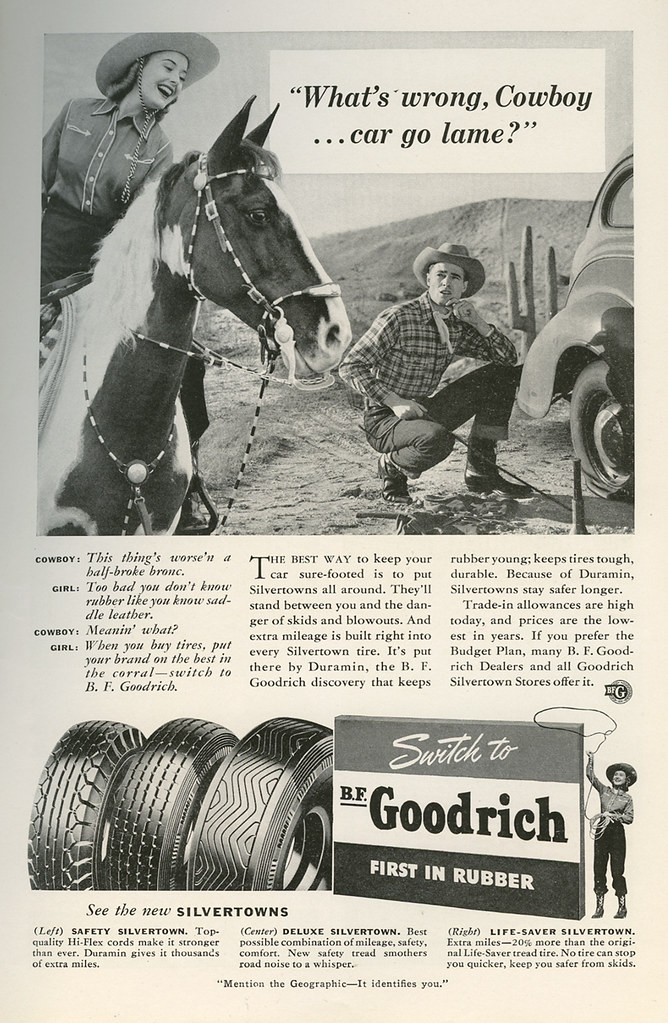This ad dates from the July 1941 National Geographic. Within months tires were being rationed due to World War II. No more cowgirls and cowboys dressed up in dude ranch duds selling tires. Ads became focused on the war effort. Carefree was gone. The country was in it together, unlike today where the war is merely an afterthought for most people. I doubt today we could get our country to accept rationing. We're too self-absorbed and foolish to think of ourselves as a nation. Everybody has their own angle.
At the beginning of World War II, a rationing system was established in the United States. The United States had an abundance of petroleum at the time nationally, but lacked enough infrastructure to transport petroleum overland to all parts of the country. Gasoline shortages were especially acute in the Eastern states because most petroleum was carried by sea by tanker, which became dangerous with U-Boats operating off the USA coast. Until the Big Inch and Little Big Inch pipelines started pumping petroleum from East Texas to the northeast states, gas supplies in the East were tight. Of equal concern for all parts of the country was a shortage of rubber for tires since the Japanese quickly conquered the rubber-producing regions of Southeast Asia. Although synthetic rubber had been invented in the years preceding the war, it had been unable to compete with natural rubber commercially, so the USA did not have enough manufacturing capacity at the start of the war to make synthetic rubber. Throughout the war, rationing of gasoline was motivated by a desire to conserve rubber as much as by a desire to conserve gasoline.A national speed limit of 35 miles per hour was imposed to save fuel and rubber for tires. Depending on need, civilians were issued one of a number of classifications of gasoline cards, entitling them to a quantity of gasoline each week. When purchasing gasoline, one had to present a gas card and a vehicle sticker in addition to payment. Books of ration stamps were issued for other commodities and were valid only for a set period, to forestall hoarding.To get a classification and rationing stamps, one had to appear before a local War Price and Rationing Board which reported to the U.S. Office of Price Administration. Each person in a household received a ration book, including babies and small children who qualified for canned milk not available to others. To receive a gasoline ration card, a person had to certify a need for gasoline and ownership of no more than five tires. All tires in excess of five per driver were confiscated by the government, because of rubber shortages. An A sticker on a car was the lowest priority of gasoline rationing and entitled the car owner to 3 to 4 gallons of gasoline per week. B stickers were issued to workers in the military industry, entitling their holder up to 8 gallons of gasoline per week. C stickers were granted to persons deemed very essential to the war effort, such as doctors. T rations were made available for truckers. Lastly, X stickers on cars entitled the holder to unlimited supplies and were the highest priority in the system. Ministers of Religion, police, firemen, and civil defense workers were in this category. A scandal erupted when 200 Congressmen received these X stickers.Tires were the first item to be rationed in January 1942 after supplies of natural rubber were interrupted. Soon afterward, passenger automobiles, typewriters, sugar, gasoline, bicycles, footwear, fuel oil, coffee, stoves, meat, lard, shortening and oils, cheese, butter, margarine, processed foods (canned, bottled, and frozen), dried fruits, canned milk, firewood and coal, jams, jellies, and fruit butter were rationed by November 1943. (SOURCE: Wikipedia)
No matter the age of the consumer, cowgirls and cowboys were hot sellers. I guess now it's phony superheros from comic books or celebrities with bad attitudes. I'm just not sure.













This post made me want my own chickens. I dunno... just want some chickens. Eggs, meat...wonder if I could get away with it here in town....
ReplyDelete